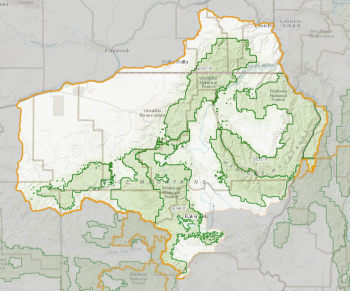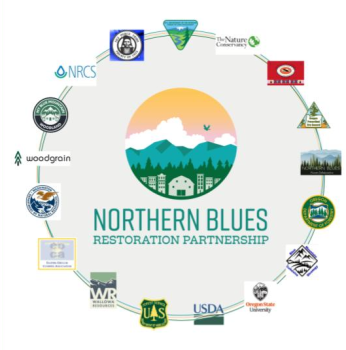Collaborative Forest Landscape Restoration in the Northern Blues
The Collaborative Forest Landscape Restoration Project which was awarded in 2020 and first implemented in 2021. This award includes annual funding of 3 million dollars over a for 10 year period.
Following a highly competitive national application process for funding under the Collaborative Forest Landscape Restoration Program (CFLRP), the US Department of Agriculture awarded $3 million to implement the Northern Blues CFLRP Proposal in fiscal year (FY) 2021, which started October 1, 2020. The project is approved for funding for up to ten years, depending on appropriation levels from Congress and reauthorization of the CFLRP program in 2023.
The proposal was developed by the Umatilla and Wallowa-Whitman National Forests with diverse partners who bring a strong record of cross-boundary restoration spanning Northeastern Oregon and Southeastern Washington.
Because of the long‐term suppression of naturally occurring wildfires and past management that removed fire-tolerant trees, the forests and communities of the northern Blue Mountains face increasing risk of severe wildfires. Therefore, the partners united around two common goals:
(1) improve wildfire resilience
(2) restore more natural processes to forests and watersheds
The objective of this work, whether through thinning or prescribed fire, is to enhance forest health and resilience. These projects will benefit many areas on the National Forests that are not commercially viable and contain small diameter trees. In addition, some projects may also provide economic benefits and products. Work would occur in areas that are at risk from wildfires, such as areas adjacent to private lands and municipal watersheds, and other important locations. Treatments would maintain and enhance old trees and existing old-growth stands.
2024 Update:
Forest Supervisors and the CFLRP Core Committee have selected the following CFLRP projects to fund for FY25 (see screenshot below). Congratulations to the proponents and their respective districts. Thank you to all who applied. If your proposal was not funded this year, be not discouraged. Six years of CFLRP funding remains. The time, effort and attention put into each application was felt and appreciated.
Funded FY25 CFLRP projects were selected from a pool of 26 proposals requesting a cumulative 9.2 million in funding. Unit priorities, projects with signed NEPA and broader CFLRP goals (restoration focus, degree of cross boundary coordination, proximity to WUI and partner involvement) where considered.
The CLFRP Footprint
The CFLRP cover 10 million acres of federal, state, tribal and private lands.
The Restoration Partnership consists of many local organizations
Initial funding will allow the Forest Service to implement thousands of acres of already planned projects to reduce the risk of destructive wildfires. In future years, strategic landscape treatments will be designed to take advantage of existing features (roads, ridges, and other barriers) to extend treated areas and further reduce wildfire severity. If fully funded and implemented over 10 years, the partners could treat up to 900,000 acres of National Forest, Tribal, State, and private lands – roughly 20 percent of the Northern Blues forested landscape.
This effort builds on CFLRP restoration accomplishments in the Southern Blue Mountains, including the Malheur National Forest. It is also informed by analyses conducted by the Northern Blues Cohesive Wildfire Strategy Partnership and the Forest Service’s Eastside Restoration Program. The Umatilla and Wallowa-Whitman National Forests plan to continue working with partners to prioritize and implement projects based on available capacity and funds, both from CFLRP as well as other funding opportunities.
Latest Updates
- National Forests and partners commit to projects that will improve forest resilience across northern Blue Mountains (October 8, 2020)
Additional information about CFLRP
Congress established CFLRP to encourage the collaborative, science-based ecosystem restoration of priority forest landscapes. The program supports work with partner agencies, organizations, and landowners in an all-lands approach to forest restoration.
National CFLRP Program Information







